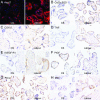Oxidative stress, gene expression, and protein changes induced in the human placenta during labor
- PMID: 17823277
- PMCID: PMC1988867
- DOI: 10.2353/ajpath.2007.070528
Oxidative stress, gene expression, and protein changes induced in the human placenta during labor
Abstract
Malperfusion of the placenta has been implicated as a cause of oxidative stress in complications of human pregnancy, leading to release of proinflammatory cytokines and anti-angiogenic factors into the maternal circulation. Uterine contractions during labor are known to be associated with intermittent utero-placental perfusion. We therefore tested whether oxidative stress, proinflammatory cytokines, and angiogenic regulators were increased in placentas subjected to short (<5 hours) and long (>15 hours) labor compared with nonlabored controls delivered by cesarean section. In addition, broader changes in gene transcripts were assessed by microarray analysis. Oxidative stress, activation of the nuclear factor-kappaB pathway, tumor necrosis factor-alpha and interleukin 1beta all increased in placental tissues after labor. Stabilization of hypoxia-inducible factor-1alpha and increased vascular endothelial growth factor soluble receptor-1 were also observed. By contrast, tissue levels of placenta growth factor decreased. Apoptosis was also activated in labored placentas. The magnitude of these changes related to the duration of labor. After labor, 55 gene transcripts were up-regulated and 35 down-regulated, and many of these changes were reflected at the protein level. In conclusion, labor is a powerful inducer of placental oxidative stress, inflammatory cytokines, and angiogenic regulators. Our findings are consistent with intermittent perfusion being the initiating cause. Placentas subjected to labor do not reflect the normal in vivo state at the molecular level.
Figures







Similar articles
-
Down-regulation of placental neuropilin-1 in fetal growth restriction.Am J Obstet Gynecol. 2016 Feb;214(2):279.e1-279.e9. doi: 10.1016/j.ajog.2015.09.068. Epub 2015 Sep 26. Am J Obstet Gynecol. 2016. PMID: 26409917
-
Differential expression of calcium transport channels in placenta primary cells and tissues derived from preeclamptic placenta.Mol Cell Endocrinol. 2013 Mar 10;367(1-2):21-30. doi: 10.1016/j.mce.2012.12.012. Epub 2012 Dec 23. Mol Cell Endocrinol. 2013. PMID: 23267838
-
Expression and activity of Toll-like receptors 1-9 in the human term placenta and changes associated with labor at term.Biol Reprod. 2009 Feb;80(2):243-8. doi: 10.1095/biolreprod.108.069252. Epub 2008 Sep 24. Biol Reprod. 2009. PMID: 18815357
-
Matrix Metalloproteinases in Normal Pregnancy and Preeclampsia.Prog Mol Biol Transl Sci. 2017;148:87-165. doi: 10.1016/bs.pmbts.2017.04.001. Epub 2017 May 22. Prog Mol Biol Transl Sci. 2017. PMID: 28662830 Free PMC article. Review.
-
Factors implicated in the initiation of human parturition in term and preterm labor: a review.Gynecol Endocrinol. 2015;31(9):679-83. doi: 10.3109/09513590.2015.1076783. Epub 2015 Aug 24. Gynecol Endocrinol. 2015. PMID: 26303116 Review.
Cited by
-
Endoplasmic reticulum stress in the pathogenesis of early-onset pre-eclampsia.Pregnancy Hypertens. 2011 Jan;1(1-2):72-8. doi: 10.1016/j.preghy.2010.12.002. Pregnancy Hypertens. 2011. PMID: 22242213 Free PMC article.
-
Vitamin D Supplementation Improves Mitochondrial Function and Reduces Inflammation in Placentae of Obese Women.Front Endocrinol (Lausanne). 2022 May 31;13:893848. doi: 10.3389/fendo.2022.893848. eCollection 2022. Front Endocrinol (Lausanne). 2022. PMID: 35712242 Free PMC article.
-
The Effect of Maternal Diet with Fish Oil on Oxidative Stress and Inflammatory Response in Sow and New-Born Piglets.Oxid Med Cell Longev. 2019 Jun 2;2019:6765803. doi: 10.1155/2019/6765803. eCollection 2019. Oxid Med Cell Longev. 2019. PMID: 32082476 Free PMC article.
-
Effects of High Intensity Interval Training on Pregnant Rats, and the Placenta, Heart and Liver of Their Fetuses.PLoS One. 2015 Nov 13;10(11):e0143095. doi: 10.1371/journal.pone.0143095. eCollection 2015. PLoS One. 2015. PMID: 26566220 Free PMC article.
-
Preterm prelabor rupture of the membranes: A disease of the fetal membranes.Semin Perinatol. 2017 Nov;41(7):409-419. doi: 10.1053/j.semperi.2017.07.012. Epub 2017 Aug 12. Semin Perinatol. 2017. PMID: 28807394 Free PMC article. Review.
References
-
- Hubel CA. Oxidative stress in the pathogenesis of preeclampsia. Proc Soc Exp Biol Med. 1999;222:222–235. - PubMed
-
- Myatt L, Cui X. Oxidative stress in the placenta. Histochem Cell Biol. 2004;122:369–382. - PubMed
-
- Burton GJ, Jauniaux E. Placental oxidative stress: from miscarriage to preeclampsia. J Soc Gynecol Invest. 2004;11:342–352. - PubMed
-
- Brosens IA. Morphological changes in the utero-placental bed in pregnancy hypertension. Clin Obstet Gynaecol. 1977;4:573–593. - PubMed
-
- Kim YM, Bujold E, Chaiworapongsa T, Gomez R, Yoon BH, Thaler HT, Rotmensch S, Romero R. Failure of physiologic transformation of the spiral arteries in patients with preterm labor and intact membranes. Am J Obstet Gynecol. 2003;189:1063–1069. - PubMed
Publication types
MeSH terms
Substances
Grants and funding
LinkOut - more resources
Full Text Sources
Other Literature Sources
Medical
Research Materials

